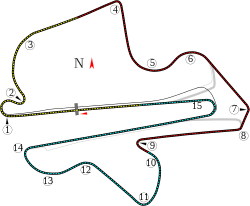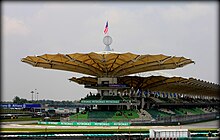Sepang International Circuit
  | |
| Location | Sepang, Selangor, Malaysia |
|---|---|
| Time zone | UTC+08:00 |
| Coordinates | 2°45′38″N 101°44′15″E / 2.76056°N 101.73750°ECoordinates: 2°45′38″N 101°44′15″E / 2.76056°N 101.73750°E |
| Capacity | 130,000 |
| FIA Grade | 1 |
| Broke ground | 1 November 1997 |
| Opened | 7 March 1999 |
| Architect | Hermann Tilke |
| Major events | Formula One Malaysian Grand Prix (1999–2017) FIM MotoGP Malaysian Grand Prix (1999–2019) Malaysia Merdeka Endurance Race Asian Le Mans Series (2013-2020) F3 Asian Championship (2018-2020) WTCR (2019) FIM Endurance World Championship (2019) |
| Main Circuit (1999–present) | |
| Length | 5.543 km (3.445 mi) |
| Turns | 15 |
| Race lap record | 1:34.080 ( |
| North Circuit | |
| Length | 2.706 km (1.681 mi) |
| Turns | 9 |
| South Circuit | |
| Length | 2.609 km (1.621 mi) |
| Turns | 8 |
| Website | www |
| Type | Government-linked company |
|---|---|
| Founded | 1997 |
| Headquarters | Jalan Pekeliling, 64000 Sepang, Selangor, Malaysia |
Key people | Mohamed Azman Yahya, Chairman Azhan Shafriman Hanif, Chief Executive Officer |
| Parent | Minister of Finance Incorporated |
| Website | www |
The Sepang International Circuit (Malay: Litar Antarabangsa Sepang) is a motorsport race track in Sepang, Selangor, Malaysia. It is located approximately 45 km (28 mi) south of Kuala Lumpur, and close to Kuala Lumpur International Airport. It hosted the Formula One Malaysian Grand Prix between 1999 and 2017, and is also the venue for the Malaysian Motorcycle Grand Prix, the Malaysia Merdeka Endurance Race and other major motorsport events.
History[]

The circuit was designed by German designer Hermann Tilke, who would subsequently design circuits including in Shanghai, Sakhir, Istanbul, Marina Bay and Yas Marina. As part of a series of major infrastructure projects in the 1990s under Mahathir Mohamad's government, the Sepang International Circuit was constructed between 1997 and 1999 close to Putrajaya, the then-newly founded administrative capital of the country, with the intent of hosting the Malaysian Grand Prix. Similar to other of the country's circuits, the circuit is known for its unpredictable humid tropical weather, varying from clear furnace hot days to tropical rain storms.
The circuit was officially inaugurated by the 4th Prime Minister of Malaysia Mahathir Mohamad on 7 March 1999 at 20:30 MST (UTC+08:00). He subsequently went on to inaugurate the first Moto GP Malaysian Grand Prix on 20 April 1999 (see 1999 Malaysian motorcycle Grand Prix) and the first Formula One Petronas Malaysian Grand Prix on 17 October 1999 (see 1999 Malaysian Grand Prix).

On 23 October 2011, on the second lap of the MotoGP Shell Advance Malaysian Grand Prix, the Italian motorcycle racer Marco Simoncelli died following a crash in turn 11 on Lap 2, resulting in an abandonment of the race.
The track was completely resurfaced in 2016, with several corners reprofiled to emphasize mechanical, rather than aerodynamic grip. Notably, the final corner was raised by approximately 1 meter, which officials claimed would force drivers to take a later apex and explore different racing lines through the hairpin.
In October 2016 it was rumored that the Sepang circuit may be dropped from the Formula One calendar due to dwindling ticket sales, and held its nineteenth and last World Championship Grand Prix in 2017.[1] The race's contract was due to expire in 2018, but its future had been under threat due to rising hosting fees and declining ticket sales.
Layout[]

The main circuit, normally raced in a clockwise direction, is 5.543 kilometres (3.444 mi) long, and is noted for its sweeping corners and wide straights.[citation needed] The layout is quite unusual, with a very long back straight (927 metres) separated from the pit straight by just one very tight hairpin.
Other configurations of the Sepang circuit can also be used. The north circuit is also raced in a clockwise direction. It is basically the first half of the main circuit. The course turns back towards the pit straight after turn 6 and is 2.71 kilometres long in total.
The south circuit is the other half of the racecourse. The back straight of the main circuit becomes the pit straight when the south circuit is in use, and joins onto turn 8 of the main circuit to form a hairpin turn. Also run clockwise, this circuit is 2.61 km in length.
Sepang International Circuit also features kart racing and motocross facilities.
A lap in a Formula One car[]

Sepang starts with a long pit straight where the DRS zone exists – crucial for drivers to get a good exit out of the last corner to gain as much speed as possible. Turn 1 is a very long, slow corner taken in second gear. Most drivers brake incredibly late and lose speed gradually as they file round the corner, similar to Shanghai's first turn but slower. Turn 1 leads straight into Turn 2, a tight left hairpin which goes downhill quite significantly. The first two corners are quite bumpy, making it hard to put power onto the track.[2] Turn 3 is a long flat out right hander which leads into Turn 4 – known locally as the Langkawi Curve[3] – a second gear, right-angle right-hander. Turns 5 and 6 make up an incredibly high-speed, long chicane that hurts tyres and puts a lot of stress on drivers due to high G-Force. It is locally known as the Genting Curve.[3] Turns 7 and 8 (the KLIA curve) make up a long, medium-speed, double-apex right hander, and a bump can cause the car to lose balance here.[2] Turn 9 is a very slow left-hand hairpin (the Berjaya Tioman Corner[3]), similar to turn two but uphill. Turn 10 leads into a challenging, medium-speed right hander at turn 11, requiring braking and turning simultaneously. Turn 12 is a flat-out, bumpy left which immediately leads into the flat right at turn 13, then the challenging 'Sunway Lagoon'[3] curve at turn 14. Similar to turn 11, it requires hard-braking and steering at the same time. It is taken in second gear. The long back straight can be a good place for drivers to overtake as they brake hard into turn 15, a left-handed, second-geared hairpin but drivers are advised by experts to be careful not to get re-overtaken as they come into turn 1.
Lap records[]
Fatalities[]
- Marco Simoncelli – MotoGP 2011
- – Asia Talent Cup 2019
See also[]
References[]
- ^ "Malaysian Grand Prix: Sepang could leave F1 calendar over ticket sales". www.bbc.com/sport. Retrieved 25 October 2016.
- ^ Jump up to: a b "Sepang Track Guide". F1 Fanatic. Retrieved 17 December 2012.
- ^ Jump up to: a b c d "Sepang International Circuit". Super GT. Retrieved 17 December 2012.
- ^ "2019-2020 4 Hours of Sepang Best laptimes per driver" (PDF). Retrieved 17 March 2021.
- ^ "2008 Super GT International Series Malaysia". Retrieved 31 March 2021.
- ^ "2017-2018 4 Hours of Sepang Best laptimes per driver" (PDF). Retrieved 17 March 2021.
- ^ "2019–20 F3 Asian Championship Winter Series Round 3 Race 1 Results" (PDF). Retrieved 17 March 2021.
- ^ "2018-2019 4 Hours of Sepang Best laptimes per driver" (PDF). Retrieved 17 March 2021.
- ^ "2013 Super GT International Series Malaysia". Retrieved 31 March 2021.
- ^ "2004 Sepang Formula Nippon". Retrieved 17 June 2021.
- ^ "2016-2017 Asian Le Mans Series Round 4 F4 Race 4 Results" (PDF). Retrieved 17 May 2021.
- ^ "2019 TCR Asia Sepang Race 2 Results" (PDF). Retrieved 17 May 2021.
- ^ "FIM EWC 2019 8 Hours of Sepang Final Results". Retrieved 17 March 2021.
- ^ "SRO Asia Sepang 2018". Retrieved 31 March 2021.
- https://www.sepangcircuit.com/events/formula-1-petronas-malaysia-grand-prix/event-info
- https://www.sepangcircuit.com/about/history
External links[]
 Media related to Sepang International Circuit at Wikimedia Commons
Media related to Sepang International Circuit at Wikimedia Commons- Official website
- Map and circuit history at RacingCircuits.info
- Sepang International Circuit on Google Maps (Current Formula 1 Tracks)
- Government-owned companies of Malaysia
- Motorsport venues in Malaysia
- Sepang District
- Sports venues in Selangor
- Formula One circuits
- Malaysian Grand Prix
- Grand Prix motorcycle circuits
- A1 Grand Prix circuits
- Racing circuits designed by Hermann Tilke
- 1999 establishments in Malaysia
- Sports venues completed in 1999
- Minister of Finance (Incorporated) (Malaysia)
- Privately held companies of Malaysia
